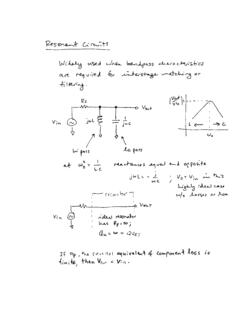Transcription of Audio Amplifier Circuit - UC Santa Barbara
1 1 Bob York ECE 2C Laboratory Manual 1a Audio Amplifier Circuit Overview In the first part of lab#1 you will construct a low-power Audio Amplifier /speaker driver based on the LM386 IC from National Semiconductor. The Audio Amplifier will be a self-contained, battery-operated component. In the second part of the lab you will construct a microphone Circuit using a compact electret condenser microphone cartridge.
2 These Circuit modules are important building blocks of many Audio communications systems, and will be used in our ultrasonic transceiver system. By studying this document and experimenting with the components and circuits in the lab, pay attention to the following: Electrical characteristics of Audio speakers Characteristics of condenser microphones Design of single -supply battery-operated op-amp circuits Use of diode limiters/clamps for input protection Use of active filters for tone control Choice of AC coupling capacitors We will discuss the analytical aspects of active filter design in lecture we will see them in action again in our IR receiver system. Remember, the objective here is not simply to create a working Circuit , it is to learn about circuits!
3 So, as you progress through the lab, try to understand the role of each component, and how the choice of component value may influence the operation of the Circuit . Please tinker with component values, that is an especially valuable way to learn. Ask yourself questions such as: Why is this resistor here? Why does it have this resistance value? Why is this blocking capacitor 1 F instead of F or 10 F or 100 F? Why was this particular op-amp chosen? It is only when you can answer such questions that you will truly understand the labs and progress towards designing your own circuits. In the process you may even find a better solution; in fact, many of the laboratory experiments in this course now include several slight modifications from the original that were inspired by student feedback.
4 2 Audio Amplifier Circuit Bob York 2 Table of Contents Pre-lab Preparation 2 Before Coming to the Lab 2 Schedule for Lab #1 2 Parts List 3 Full Schematics for Lab #1 4 Background information 6 Audio Speakers 6 In-Lab Procedure 8 Some comments on our choice of ICs 8 Why the LM386? 8 Why the LM358? 8 Speaker Equivalent Circuit 9 Assemble Amplifier on Breadboard 9 Summing network 11 Optional -- Tone-Control Circuit 12 Hardwire the Amplifier 13 Possible Improvements 14 Pre-lab Preparation Before Coming to the Lab Read through the lab experiment to familiarize yourself with the components and assembly sequence. Before coming to the lab, each group should obtain a parts kit from the ECE Shop. With reference to the full schematic in Figure 1-1 calculate the lower cutoff frequency imposed by capacitors C1-3 and R1-3 in the summing network: lowf=_____Hz Schedule for Lab #1 To stay on schedule, you must do the following: Week #1: Audio Amplifier Week #2: Microphone Circuit The Audio Amplifier project is more difficult and time-consuming than the microphone pre-amp, so part of week #2 may be used to finish the Audio amp.
5 All breadboarding and testing can and should be done in lab. Soldering and hardwiring can and should be done outside lab. Pre-lab Preparation 3 Bob York 3 Parts List QtyDescriptionCircuit1A ud io S pe ake r, 8- Oh m, 2 W a tt, 9K Hz1L M38 6N -3 L ow- Vo ltag e Au di o P owe r Am pli fe rU21LM358 Low-Power Dual Op-AmpU128-pin low-profile IC socket11 0 Ohm 1 /2W re sistorR1 022.
6 2 k 1/4W r esisto rR1 3,R1 4810k 1/4W resistorR1-5,R9,R12,R152100k 1/4W resistorR6-711 0k trim po tR812 0k trim po tR1 114 70 u F 16 V e lectro lyti c ca pa citor (PC l ea d)C911 00 uF 16 V e lectr olytic cap acito r (P C lea d)C1 021 0u F 1 6V ele ctro lytic ca pa citor ( PC le ad )C4 ,C 641uF capacitorC1,C2,C3, capacitor (CK05 low-voltage ceramic ) capacitor (CK05 low-voltage ceramic )C11,C1210 .1 uF ca pa citor ( CK0 5 lo w-vo ltag e cer am ic )C821N4148 small-signal Silicon " x " vectorboard4 Rubber feet1S te re o A ud io ja male-to-male stereo patch cord19V battery leads19 V ba tte ry ho lde r (a dh esi ve ba cked )19V battery1Do ub led -sid ed ad he sive tap e fo r mo un ti ng sp ea ke r2flea clips6"#22 stranded wire (black)6 "# 22 stra nd ed wire (re d) Audio Amplifier 4 Audio Amplifier Circuit Bob York 4 Full Schematics for Lab #1 Figure 1-1 Schematic for the basic Audio Amplifier .
7 Pre-lab Preparation 5 Bob York 5 Figure 1-2 Schematic for the Audio Amplifier with optional tone-control Circuit . 6 Audio Amplifier Circuit Bob York 6 Background information Audio Speakers Audio speakers convert electrical signals into mechanical motion. The most common speakers for high-quality Audio are constructed as shown in Figure 1-3.
8 The electric signal is passed through a coil of wire (the voice coil), which is suspended a strong magnetic field provided by a permanent magnet. A time-varying current in the coil leads to a mechanical deflection relative to the magnet. The coil is attached to a lightweight conical membrane (usually made from a heavy-grade paper) that couples the mechanical motion of the coil to the surrounding air molecules. (a) (b) Figure 1-3 (a) Cross section and (b) Impedance curve for a typical 8 dynamic speaker. If you look through catalogs of Audio -speakers, you will find many different sizes and price ranges.
9 For example, check out High-quality Audio speakers can be quite expensive, and are designed for a flat, omni-directional frequency response in the specified operating range. Small inexpensive speakers, such as the ones used in this lab, have poor low-frequency response and limited power-handling capacity. Speakers are commonly specified by their frequency response, impedance level, and power-handling capacity. Typical speaker impedances are 8 or 4 or 16 . This is often a source of confusion because it suggests the speaker is modeled by a constant resistance of this value. In reality there is a significant reactive component of impedance and hence a strong variation of impedance with frequency, as shown in the figure above.
10 The impedance can also depend strongly on the surroundings. For example, a speaker measured in isolation (the free-air response) will have a different impedance than one mounted in a wooden enclosure. D. B. Weems, Designing, Building & Testing your Own Speaker System, Tab Books: Blue Ridge Summit, PA, 1984 Band of operation Resonance Background information 7 Bob York 7 The AC impedance often











